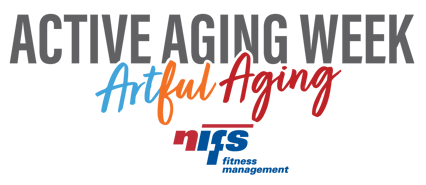 As the seasons change and leaves take on vibrant hues of red, yellow, and orange we are reminded that much like an artist, we can craft our lives in beautiful ways, and what better time to celebrate that reminder with our senior residents than during Active Aging Week? Active Aging Week, celebrated annually, shines a light on the importance of maintaining an active and engaged lifestyle as we age. This year, at NIFS, we’ve decided to focus on “aging artfully” and help the residents in the communities that we partner with age well through embracing their creativity.
As the seasons change and leaves take on vibrant hues of red, yellow, and orange we are reminded that much like an artist, we can craft our lives in beautiful ways, and what better time to celebrate that reminder with our senior residents than during Active Aging Week? Active Aging Week, celebrated annually, shines a light on the importance of maintaining an active and engaged lifestyle as we age. This year, at NIFS, we’ve decided to focus on “aging artfully” and help the residents in the communities that we partner with age well through embracing their creativity.
As fitness professionals, we are sometimes met with surprise when we step outside of the fitness center and run programs that are more wellness and activity based, but across the country we have a team full of passionate and creative staff, and together we focus on total person health and wellness. We know that aging doesn’t mean there has to be a decline in quality of life, but instead provides opportunities to explore new passions, hobbies, and forms of self-expression. As we hold offerings to promote physical, mental, and emotional well-being this week we will also be emphasizing the role of art and creativity in active aging and bringing light to some of the benefits that come with them:
- Social Interaction: We know that not all residents in our communities are fitness buffs, so offering programs that are outside of the box gives us the ability to connect with a new group of residents and ease them into participating in other wellness programs and events. For all, joining in on creative groups and classes combats loneliness and isolation and helps to foster social connections while nurturing creativity.
- Mental Stimulation: Engaging in creative activities and trying new things stimulates and enhances cognitive function and memory while keeping your mind active.
- Emotional Well-being: Increased happiness, a sense of accomplishment, and stress reduction are all biproducts of creative expression thanks to an outlet for emotions. Participating in creative programs can help reduce stress, improve mood, and provide an avenue for processing emotions and memories.
- Self-Discovery: Exploring your creative side can help you to better understand your interests, and help you find new hobbies and passions. It’s never too late to learn an instrument, try your hand at painting, or share your wisdom. Your creative work can also become a meaningful legacy!
Some of the programs that our staff have planned for this active aging week include classes in various mediums of art, music, dance, writing, expressive exercise classes paired with music or art, outdoor exercise in nature, active adventures, upcycling projects, collaborative offerings with other departments including food and beverage, activities, physical therapy, and so much more.
Artful aging is about staying engaged in the world around us, embracing creativity and living with intention. Celebrate Active Aging Week with us by embracing the art of aging well.


.jpg?width=461&height=307&name=GettyImages-1432465103%20(1).jpg)

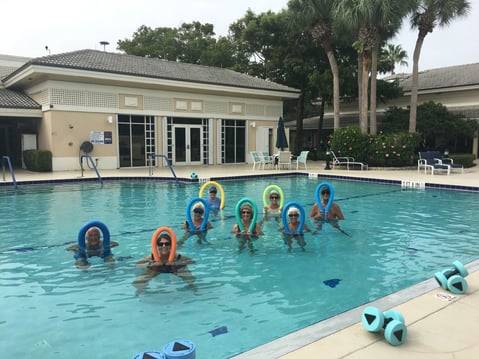 When you were a kid, going out to play was something you likely did every day. No matter if it was riding a bike, skipping rocks at the pond, or running around the neighborhood with friends, it was just fun! Moving came naturally and easy and was not considered “exercise” to the adolescent mind even though it was most certainly keeping your body healthy. The reason I bring this up is because I want you to think about those times. They were a lot of fun, weren’t they? Sometimes in our fitness center, we will hear a member say that exercise isn’t very fun. We get it! Exercise isn’t everyone’s cup of tea, but as a fitness professional, my goal is to find a way to make it fun for you. Another thing we will often here is “I’m not as young as I was!” or “I can’t do that type of movement anymore.” It is true, with the play you did as a child, there was probably a lot of falling, bumps, and bruises and that can make a person apprehensive to get started in “play” again. But that is why we are here, to explore with you and find a form of fitness that you enjoy. Yes, the several number of changes that tend to happen to the body as it goes through the stages of life can make some things more difficult, but we want to help keep it from being the reason you decide to play less.
When you were a kid, going out to play was something you likely did every day. No matter if it was riding a bike, skipping rocks at the pond, or running around the neighborhood with friends, it was just fun! Moving came naturally and easy and was not considered “exercise” to the adolescent mind even though it was most certainly keeping your body healthy. The reason I bring this up is because I want you to think about those times. They were a lot of fun, weren’t they? Sometimes in our fitness center, we will hear a member say that exercise isn’t very fun. We get it! Exercise isn’t everyone’s cup of tea, but as a fitness professional, my goal is to find a way to make it fun for you. Another thing we will often here is “I’m not as young as I was!” or “I can’t do that type of movement anymore.” It is true, with the play you did as a child, there was probably a lot of falling, bumps, and bruises and that can make a person apprehensive to get started in “play” again. But that is why we are here, to explore with you and find a form of fitness that you enjoy. Yes, the several number of changes that tend to happen to the body as it goes through the stages of life can make some things more difficult, but we want to help keep it from being the reason you decide to play less.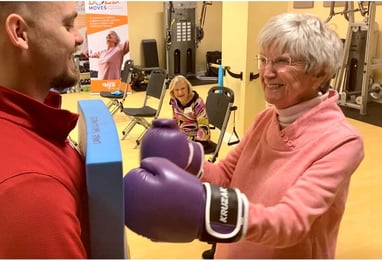 The prevalence of Parkinson’s Disease is on the rise. Previous numbers indicated that 60,000 Americans are diagnosed each year and
The prevalence of Parkinson’s Disease is on the rise. Previous numbers indicated that 60,000 Americans are diagnosed each year and 
 We work on a lot of build/design projects in retirement communities where the project is either new construction for a new community, or the plan is part of a repositioning that includes enhanced wellness spaces and services. If you follow industry trends, you see it all the time in press releases, RSS feeds and other media avenues: ground breakings for projects that include a state-of-the-art wellness wing, indoor/outdoor pool complex, etc. Communities are serious about folding resident wellness into their broader business strategy to remain viable in the market. Over my years at NIFS, I’ve had the pleasure of working on dozens of fitness center builds. As you can imagine, I’ve learned quite a bit along the way. Below are our top five recommendations (in random order) on pitfalls to avoid during your design journey.
We work on a lot of build/design projects in retirement communities where the project is either new construction for a new community, or the plan is part of a repositioning that includes enhanced wellness spaces and services. If you follow industry trends, you see it all the time in press releases, RSS feeds and other media avenues: ground breakings for projects that include a state-of-the-art wellness wing, indoor/outdoor pool complex, etc. Communities are serious about folding resident wellness into their broader business strategy to remain viable in the market. Over my years at NIFS, I’ve had the pleasure of working on dozens of fitness center builds. As you can imagine, I’ve learned quite a bit along the way. Below are our top five recommendations (in random order) on pitfalls to avoid during your design journey.
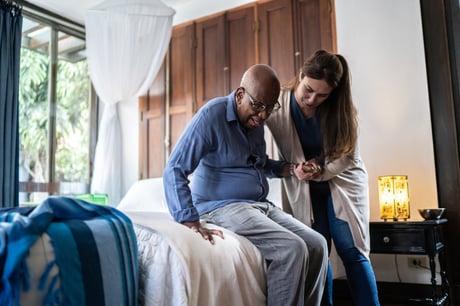 In sharing the many benefits of living in a senior living community with seniors, I often receive the response “I want to live in my home as long as I possibly can”. Making sure you are active and healthy can improve your life to maintain that desire to remain in your home. Below are 4 tips to consider before making that important decision.
In sharing the many benefits of living in a senior living community with seniors, I often receive the response “I want to live in my home as long as I possibly can”. Making sure you are active and healthy can improve your life to maintain that desire to remain in your home. Below are 4 tips to consider before making that important decision.
.jpg?width=455&height=303&name=GettyImages-516160511%20(1).jpg) Gratitude is the quality of being thankful. It is showing appreciation for giving and receiving acts of kindness. Performing acts of kindness has many benefits to our health, both mentally and physically. When we practice gratitude, we improve our daily wellbeing and overall happiness. Gratitude helps us with our mindset. We learn how to be more positive and be kinder to ourselves and others. We want to treat other people the way we want to be treated. This increases everyone’s sense of happiness which in return improves our health.
Gratitude is the quality of being thankful. It is showing appreciation for giving and receiving acts of kindness. Performing acts of kindness has many benefits to our health, both mentally and physically. When we practice gratitude, we improve our daily wellbeing and overall happiness. Gratitude helps us with our mindset. We learn how to be more positive and be kinder to ourselves and others. We want to treat other people the way we want to be treated. This increases everyone’s sense of happiness which in return improves our health.
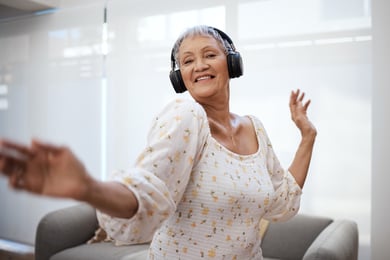
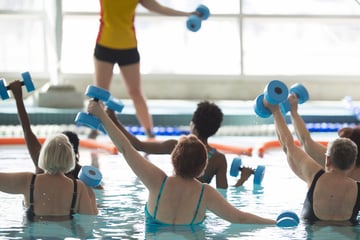 Exercising in the pool is great way to get in a workout! The water helps support you and allows you to challenge yourself! You can safely push the limits of your balance or get a thorough strength workout without putting too much stress on your joints compared to working out on land. Have you ever considered taking your flexibility workout into the pool? Increasing the range of motion within your joints and developing flexibility in major muscle and tendon groups can keep you mobile, promote better posture, and help prevent injuries. All these combine to reduce stress on your body!
Exercising in the pool is great way to get in a workout! The water helps support you and allows you to challenge yourself! You can safely push the limits of your balance or get a thorough strength workout without putting too much stress on your joints compared to working out on land. Have you ever considered taking your flexibility workout into the pool? Increasing the range of motion within your joints and developing flexibility in major muscle and tendon groups can keep you mobile, promote better posture, and help prevent injuries. All these combine to reduce stress on your body! Throughout my career in the health and fitness industry, I am constantly asked “what’s the best” cardio equipment, snacks, health bars, time of day to exercise, etc. Hopefully I can shed some light on some simple but important questions and answers.
Throughout my career in the health and fitness industry, I am constantly asked “what’s the best” cardio equipment, snacks, health bars, time of day to exercise, etc. Hopefully I can shed some light on some simple but important questions and answers.